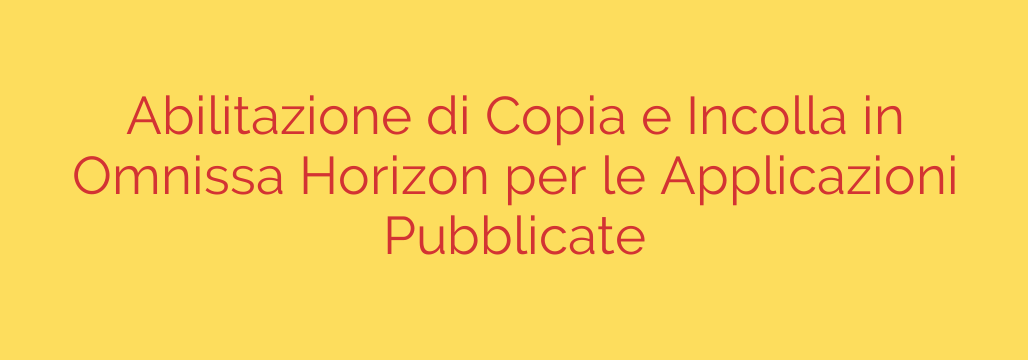
How to Securely Enable Copy and Paste in Omnissa Horizon Published Applications
In a modern digital workspace, the ability to copy and paste text and files is a fundamental expectation for productivity. However, in secure virtualized environments like Omnissa Horizon, this simple action is often disabled by default for a critical reason: data security. Unrestricted clipboard access can create a pathway for sensitive information to be exfiltrated from the corporate environment to a local machine.
As an administrator, you are tasked with balancing user convenience against security requirements. Fortunately, Horizon provides granular controls to enable this functionality safely. This guide will walk you through the proper methods to enable clipboard redirection for published applications, ensuring your users can work efficiently while you maintain a strong security posture.
Understanding Clipboard Redirection
Clipboard redirection is the feature within Omnissa Horizon that synchronizes the clipboard of the user’s local endpoint device with the virtual application or desktop session. When disabled, the two clipboards operate independently. When enabled, users can copy content on their local machine and paste it into the Horizon application, and vice-versa, depending on the configuration.
The key to a secure deployment is not simply turning the feature on, but configuring its direction and the type of content it can handle.
The Primary Method: Configuring via Group Policy (GPO)
For most environments, the most reliable and straightforward method for managing clipboard redirection is through Windows Group Policy Objects (GPOs). This requires applying a policy to the Organizational Unit (OU) containing the virtual machines or RDS hosts that serve the published applications.
Follow these steps to configure the policy:
Load the Horizon ADMX Templates: Ensure you have the VMware Horizon GPO Bundle installed on your Domain Controller. These templates add the necessary policy settings to the Group Policy Management Editor.
Navigate to the Policy: Open the Group Policy Management Editor and edit the relevant GPO. The clipboard redirection policy is located at:
Computer Configuration > Policies > Administrative Templates > VMware View Agent Configuration > Clipboard RedirectionConfigure the “Configure clipboard redirection” Setting: This is the master switch for the feature. You have several options, each with distinct security implications:
- Disabled (Default): This is the most secure setting. Clipboard redirection is completely blocked.
- Enabled client to server only: This is the recommended setting for most use cases. It allows users to copy data from their local machine and paste it into the virtual application. This is ideal for tasks like pasting a password or a snippet of text from an email. It prevents data from being copied out of the secure environment.
- Enabled server to client only: This option carries a higher security risk. It allows users to copy sensitive data from within the Horizon application and paste it onto their local machine, potentially exfiltrating company information. This should only be enabled when there is a clear and vetted business requirement.
- Enabled in both directions: This provides the most seamless user experience but also presents the greatest security risk. It allows unrestricted copying and pasting in and out of the virtual session.
Apply the Policy: Once you have configured the setting, run
gpupdate /forceon the target RDS hosts or virtual machines to apply the changes immediately, or wait for the standard GPO refresh cycle.
Advanced Security: Filtering Clipboard Content
Beyond simply controlling the direction, Horizon’s GPO settings allow you to define what type of content can be copied and pasted. This adds another powerful layer of security.
Within the same GPO path (... > Clipboard Redirection), you will find policies to control specific data formats. For example, you can explicitly block file transfers via copy and paste while still allowing text. This is an excellent way to prevent users from moving entire documents out of the environment while still permitting them to work with text-based data.
Key Security Best Practices
When enabling clipboard redirection, always operate under the principle of least privilege.
- Start with the Most Restrictive Policy: Begin by enabling clipboard access in the client-to-server direction only. This solves the most common user requests without opening a major data exfiltration vector.
- Use Conditional Policies: For more advanced control, leverage Omnissa’s Dynamic Environment Manager (DEM) or GPO filtering to apply different clipboard policies based on user group, location, or network. For example, you might allow bidirectional copy-paste for users on the internal corporate network but restrict it to client-to-server only for users connecting from external networks.
- Audit and Monitor: Ensure you have logging and monitoring in place to track user activity. While you may not see the clipboard content itself, unusual patterns of activity can be flagged for review.
- Educate Your Users: Inform users about the company’s data handling policies. When they understand the “why” behind certain restrictions, they are more likely to adhere to them.
By following these structured methods and security principles, you can provide your Omnissa Horizon users with the functionality they need to be productive without compromising your organization’s critical data integrity.
Source: https://nolabnoparty.com/omnissa-horizon-abilitare-copia-e-incolla-dalle-applicazioni-pubblicate/








